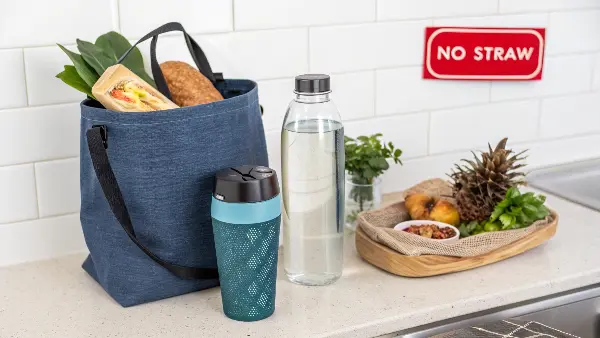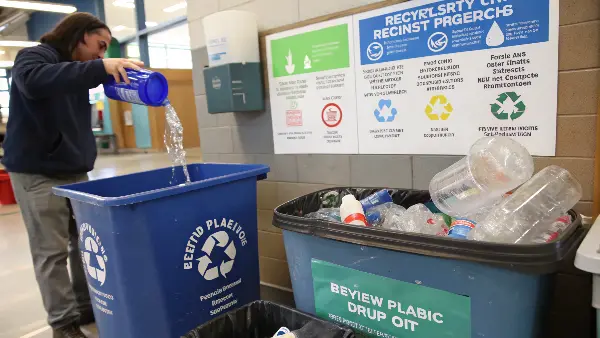Plastic surrounds us every day, from our morning coffee cup to the packaging of our dinner. It can feel overwhelming, knowing that so much of it ends up polluting our oceans and land. But you can start making a real difference with just a few small changes. This guide will show you simple, practical ways to begin.
You can significantly reduce your plastic footprint by making conscious daily choices. Start by carrying reusable items like water bottles, coffee cups, and shopping bags. Choose loose produce over pre-packaged options, and buy foods like grains and nuts from bulk bins. Cooking at home more often and avoiding single-serving snacks also dramatically cuts down on packaging waste. These small habits, when adopted consistently, lead to a massive reduction in your personal plastic consumption and help protect our planet.

These ideas are simple, but putting them into practice is what really counts. You don’t have to change everything overnight. The journey to a lower-plastic lifestyle is a marathon, not a sprint. Let’s look at how you can easily integrate these habits into your routine, starting today. Ready to dive in and see how easy it can be?
Where Do You Start with Ditching Single-Use Plastics?
You see them everywhere: disposable cups, straws, and bags. They feel convenient for a moment, but their environmental cost is huge. It’s easy to feel like you can’t avoid them. But what if the most common plastics were also the easiest to replace? A few simple swaps are all it takes to start.
To start ditching single-use plastics, focus on the "big four": plastic bags, water bottles, coffee cups, and straws. Get into the habit of carrying a reusable shopping bag, a refillable water bottle, and a travel mug. When ordering drinks, simply say "no straw, please." These four changes are easy to implement and have a massive impact because they target items used daily by millions of people. It’s about building new habits, one small step at a time.

Integrating these reusables into your life is all about making them convenient. I remember I used to forget my canvas bags all the time when I first started. My solution was to keep a few folded up in my car, another in my backpack, and one by the front door. After a few weeks, grabbing them became second nature. The key is to find a system that works for you and stick with it. It feels great when you realize you haven’t taken a plastic bag from a store in months.
Making Reusables a Habit
The trick is to place your reusable items where you won’t forget them.
- Car: Keep a stash of shopping bags in your trunk.
- Work/School Bag: Always have a water bottle and a coffee cup with you.
- By the Door: Hang your keys and your favorite shopping bag together.
A Quick Comparison
Let’s look at why this small change is so powerful.
| Item | Single-Use Problem | Reusable Solution |
|---|---|---|
| Plastic Bag | Used for ~12 minutes; pollutes for 1,000+ years. | A canvas bag can be used for years, replacing thousands of plastic ones. |
| Water Bottle | Billions are sold every year; most end up in landfill or oceans. | A stainless steel bottle is durable, keeps water cold, and saves money. |
| Coffee Cup | Lined with plastic, making them nearly impossible to recycle. | A travel mug keeps your coffee hot and prevents unnecessary waste. |
Once you master these basics, you’ll start seeing other single-use items you can easily replace.
How Can Your Kitchen Habits Cut Down on Plastic Waste?
The kitchen is often the biggest source of plastic waste in a home. Think about it: food wrappers, containers, cling film, and produce bags. It all adds up quickly. You might feel like it’s impossible to buy food without plastic. But with a few smart choices, you can turn your kitchen into a low-waste hub.
You can cut down kitchen plastic waste by cooking more meals at home and buying ingredients in bulk. Avoid single-serving snacks and pre-packaged produce. Instead, bring your own bags for fruits and vegetables and use reusable containers for grains, nuts, and liquids from bulk bins. Swapping plastic wrap for beeswax wraps or silicone lids is another simple, effective change for storing leftovers. These actions reduce packaging and often save you money.

I made a huge change when I started visiting the bulk section of my local grocery store. At first, it seemed a bit strange to bring my own jars and bags. But I quickly realized how much packaging I was avoiding, not to mention the money I saved by buying just the amount I needed. Cooking meals from scratch also made a big difference. Instead of buying a pre-made sauce in a plastic jar, I learned to make my own with fresh tomatoes. It not only tastes better but also completely eliminates that packaging waste.
Rethink Your Grocery List
Your power to reduce waste starts before you even enter the store.
- Meal Plan: Plan your meals for the week. This helps you buy only what you need and avoid impulse buys that often come in plastic.
- Bulk First: Prioritize stores with good bulk sections. You can get pasta, rice, beans, spices, and even oil and vinegar without any packaging.
- Farmer’s Markets: These are great for finding fresh, local produce without plastic wrap. Just remember to bring your own bags.
Smart Plastic-Free Storage
Once you bring your food home, how you store it matters too.
| Instead Of… | Try This… | Why It’s Better |
|---|---|---|
| Cling Wrap | Beeswax wraps or silicone lids | Reusable, washable, and keeps food just as fresh. |
| Ziploc Bags | Silicone food pouches or glass containers | Durable, dishwasher-safe, and perfect for leftovers or lunches. |
| Plastic Tubs | Glass jars (repurpose old sauce jars!) | Free, endlessly reusable, and great for storing bulk items. |
These small shifts in your kitchen routine will have a noticeable impact on the amount of trash you produce each week.
How Can Your Shopping Choices Go Beyond Groceries?
Reducing your plastic footprint isn’t just about what’s in your grocery cart. Our other shopping habits, from clothing to electronics, contribute a lot of waste. Fast fashion creates textile waste, and new gadgets come with layers of plastic packaging. But by thinking differently about how we acquire things, we can make a huge impact.
Reduce your plastic impact by choosing to buy secondhand items whenever possible. Thrift stores, online marketplaces, and consignment shops are great for clothes, furniture, and electronics. When you must buy new, support brands that use minimal, plastic-free packaging. Finally, focus on buying durable, high-quality items that will last for years, which avoids the cycle of consumption and waste altogether. A "buy it for life" mentality is key.

I used to love the thrill of buying new things, but I started to notice how much junk I was accumulating. One day, I needed a new bookshelf. Instead of going to a big-box store, I checked a local online marketplace. I found a beautiful solid wood shelf for less than half the price of a new one made from particleboard. It had a few scratches, but it had character. This experience completely changed my perspective. Now, buying secondhand is my first choice, not my last resort. It saves money, supports my community, and keeps perfectly good items out of the landfill.
Embrace the Secondhand Economy
There are so many ways to find great pre-owned items.
- Local Thrift Stores: Perfect for finding unique clothing, home goods, and books.
- Online Marketplaces: Sites like Facebook Marketplace or Craigslist are great for furniture and local pickups.
- Consignment Shops: Find higher-end clothing and accessories in great condition.
When You Must Buy New
Sometimes, you can’t find what you need secondhand. Here’s a checklist for making better new purchases.
- Do I really need this? Pause and think before you buy. Can you borrow it or repair what you already have?
- Is it built to last? Look for items made from durable materials like metal, wood, or glass instead of plastic. Read reviews about the product’s longevity.
- What is the packaging like? Support companies that use cardboard, paper, or other compostable materials. Some brands are even going package-free. If a product is over-packaged in plastic, consider looking for an alternative.
Thinking about the entire lifecycle of a product—from its creation to its disposal—is a powerful way to reduce your overall footprint.
What About the Plastics You Can’t Avoid?
Even with the best intentions, it’s nearly impossible to eliminate all plastic from your life. Some items, like medical supplies or certain food products, rely on it. This is where proper disposal and understanding recycling becomes crucial. Just tossing everything in the blue bin isn’t enough; we need to be smart about it.
For the plastics you can’t avoid, focus on effective recycling. First, check your local recycling guidelines to learn exactly which types of plastic (e.g., #1, #2, #5) are accepted in your area. Always rinse containers to remove food residue, as contamination can ruin an entire batch of recyclables. For plastics that aren’t recyclable curbside, look for special drop-off programs, such as those for plastic bags at grocery stores.

I used to be a "wish-cycler." I’d toss any plastic item into the recycling bin, hoping it would get sorted out. I later learned that this does more harm than good. Putting the wrong items in can jam machinery and contaminate valuable materials, sending the entire load to the landfill. I took an afternoon to read my city’s recycling guide, and I was shocked at what I was doing wrong. Now, I have a small chart taped inside my cabinet above the recycling bin. It’s a simple reminder of what goes where, and it makes me confident that I’m actually helping, not hurting, the process.
Recycling Best Practices
Mastering recycling is simple once you know the rules.
- Check the Number: Look for the small number inside the chasing arrows symbol. Your local program will specify which numbers they accept.
- Clean and Dry: Food and liquids are contaminants. A quick rinse is all it takes to ensure the plastic can be processed.
- Size Matters: Small items like bottle caps or straws often fall through sorting machinery. It’s best to throw them in the trash unless your local program says otherwise (some ask you to put caps back on bottles).
Going Beyond the Blue Bin
Many common plastic items aren’t accepted in curbside programs but can be recycled elsewhere.
| Item | The Problem | The Solution |
|---|---|---|
| Plastic Film/Bags | Tangled in sorting machines. | Many major grocery stores have special collection bins at the entrance. |
| Styrofoam | Bulky, lightweight, and hard to recycle. | Search for mail-in programs or local drop-off centers that specifically handle it. |
| Toothbrushes/Razors | Made of mixed materials. | Brands like TerraCycle offer mail-in "Zero Waste Boxes" for hard-to-recycle items. |
Properly managing the plastic you can’t avoid is just as important as reducing your consumption in the first place. It ensures that valuable materials get a second life instead of becoming pollution.
Conclusion
Reducing your plastic footprint doesn’t require a complete life overhaul. It starts with simple, conscious choices—carrying a reusable bag, buying in bulk, or fixing something instead of replacing it. Each small action joins a larger movement, creating a powerful ripple effect that protects our planet for the future.


